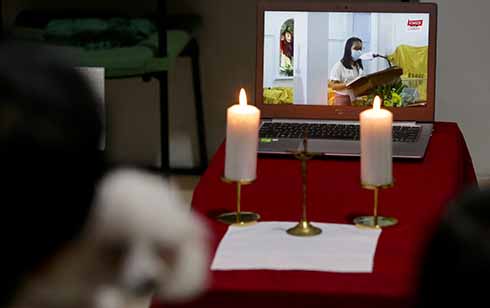 The way ‘the breaking of the bread’ is celebrated, has changed many times since the apostles sat down at the Last Supper with Jesus. Following his death and resurrection, the disciples gathered to share a meal and to celebrate the presence of the risen Christ in their midst. Their practices were reflective of local Jewish customs.
The way ‘the breaking of the bread’ is celebrated, has changed many times since the apostles sat down at the Last Supper with Jesus. Following his death and resurrection, the disciples gathered to share a meal and to celebrate the presence of the risen Christ in their midst. Their practices were reflective of local Jewish customs.
Symbols were chosen for the gathering to link to memories of past occasions that were important. Bread and wine, powerful representations of Christ’s presence, also symbolised the meal that was simple, unifying, and essential for satisfying hunger. It was celebratory in nature, providing a hope-filled outlook for the future. Christ’s presence was also recognised in the reading of scripture and letters from disciples on the road.
The Eucharist evolved as the people of God connected their contemporary views of Christ with the historical events of Jesus’ life and resurrection.
A time of change
Vatican Council II heralded significant changes in the 1960s. For the first time in centuries, Mass could be said in the language of the local people. People were encouraged to fully participate in both the liturgy of the word and the liturgy of the Eucharist as readers and Communion ministers. Everyone, including the priest, could experience the fulsome connection to the psalms and other passages of prayer and lamentation through fresh musical interpretations. These changes were driven by a need to restore the celebration of the Eucharist to the transformative experience of dying and rising with Christ. It was realised that active participation is required to enable transformation to occur.
Full participation by the people of God had been eroded by the beliefs of generations. The deep sense of piety attached to the celebration of the Eucharist resulted in people abstaining from receiving Communion until it was ruled that Communion must be received at least once a year. People satisfied their spiritual needs through the observation of rituals performed by a priest who was considered more worthy of the responsibility of representing Christ’s presence in the celebration.
Covid has created challenges for the celebration of Mass. Church closures initially prevented any gathering at all. During those times of closure, people continued their worship by joining online and television broadcasts. For some, the opportunity opened new ways to experience the Eucharist that were satisfying and spiritually nourishing. For others, screen-based participation was a poor substitute, lacking the physical presence of a gathered community and the sacramental presence of Christ through the Eucharistic mystery. With the re-opening of churches, live attendance at Mass has been met with changes to the ways we can greet each other while maintaining safe distancing, how we offer peace to one another, the distribution of Communion and how we can gather for hospitality.
Preparation
For the virtual experience to have a transformative effect through active participation, it would be helpful to make good preparations for the Mass. A sacred space can be created with a table that is laid with cloth, the colour of the liturgical season. The symbols of the Eucharist can be placed on the table and include bread and wine, a candle, and a crucifix.
The liturgy of the word can be viewed from sources such as an electronic device, a missal or the local parish bulletin. The electronic device becomes the link to the gathered community. Where possible, the viewing is shared with someone who also joins in saying the prayers and responses and singing the hymns. Singing off key should not be an excuse for silence at home.
In a live broadcast of Mass, it is important the online viewers are acknowledged as it brings their virtual presence into the conscious presence of those gathered in the church. In this way, Christ’s presence among those ‘gathered’ is experienced by all.
Being able to view the funeral of a loved one through a virtual portal has brought great comfort to those unable to attend in person. Families spread across the world have also shared the sacraments of marriage, Confirmation and First Holy Communion. Participation in online liturgies has been a transformative experience.
Community
For those who can gather in person, the disruption of Covid has been the cause to reflect on the meaning of community. Being grateful for one another’s presence gives a sense of purpose to face the uncertainty of what lies ahead.
It is a time to unite, to be aware of those who cannot attend in person, reach out to them, and enable their participation in the Eucharist. Parishes need to be mindful of those who cannot attend and continue to offer alternatives that are truly inclusive of their presence – through their acknowledgment in livestreamed events, through promotion of livestream options, the offering of Communion in the home and the assurance of safe practices at live celebrations when they can attend in person
Louise Wellington is Australian Province of the Society of Jesus delegate for pastoral ministries.